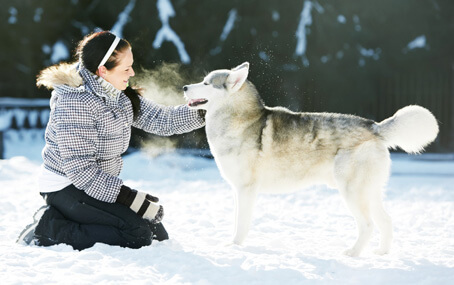
Brrrr—it’s cold outside! The following guidelines will help you protect your companion animals when the temperature dips.
1. Keep your cat inside. Outdoors, felines can freeze, become lost or be stolen, injured or killed. Cats who are allowed to stray are exposed to infectious diseases, including rabies, from other cats, dogs and wildlife. If you do have an outdoor cat, heated water bowls are recommended as well as providing a dry, clean protected place for your cat to sleep.
2. Thoroughly wipe off your dog’s legs, paws and stomach when he comes in out of the sleet, snow or ice. He can ingest salt, antifreeze or other potentially dangerous chemicals while licking his paws, and his paw pads may also bleed from snow or encrusted ice. Booties are recommended for dogs that are sensitive to the cold and salt. For dogs with short hair coats, coats are also recommended in the extreme cold.
3. Do not shave your dog down to the skin in the winter, as a longer coat will provide more warmth. When you bathe your dog in the colder months, be sure to completely dry him before taking him out for a walk
4. Puppies do not tolerate the cold as well as adult dogs, and may be difficult to housebreak during the winter. If your dog is sensitive to the cold due to age, illness or breed type, take him outdoors only to relieve himself.
5. Make sure your companion animal has a warm place to sleep, off the floor and away from all drafts. A cozy dog or cat bed with a warm blanket or pillow is perfect.
Hypothermia occurs when the body temperature goes below 100.5°F. The normal body temperature of dogs and cats is between 101 and 102.5°F. If the rectal temperature of a dog or cat is below 100.5°F, the pet is suffering from hypothermia. Usually the pet is lethargic and doesn’t have much of an appetite. The cause may be environmental, such as being exposed to cold air, or metabolic, such as kidney or heart failure. Regardless of the cause, the low temperature indicates that the pet is in need of urgent veterinary attention.
Hypothermia may be a sign of serious illness (i.e., diabetes, heart failure, shock or serious infection, among others). Do not overlook its significance. Hypothermia is especially a problem in cats and small dogs, and it can contribute to shock and organ failure. It is very important that hypothermic pets receive medical attention right away.
What to Do:
- Move the pet to a warm environment.
- Bundle the pet in warm blankets. You can warm the blankets by putting them in a clothes dryer.
- Put a hot water bottle in the blankets to add heat.
- Seek veterinary attention.
What NOT to Do
- Do not risk causing burns by using blankets, heating pads, water, etc., that are too hot; that may damage the skin.
- Do not use excess superficial heat. This may cause superficial blood vessels to dilate, resulting in shock.
- Do not allow the pet to lie directly on a heating pad – use several layers of towels and make sure it is set on LOW.
Ashley Rossman DVM, CVA

